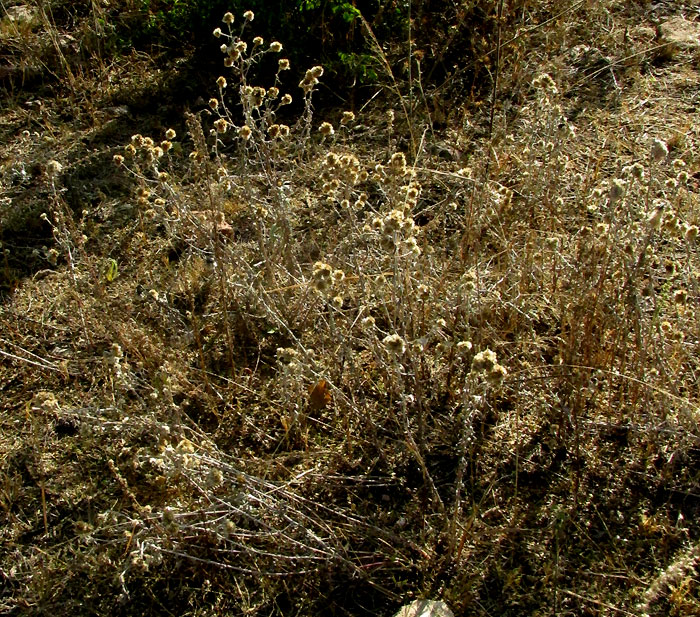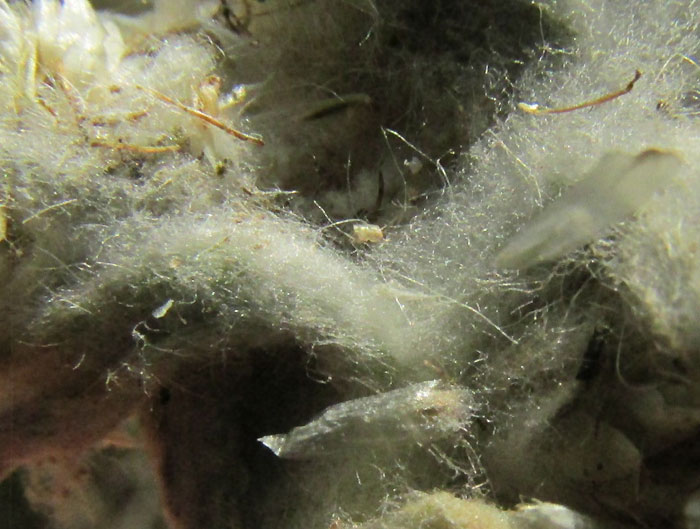Excerpts from Jim Conrad's
Naturalist Newsletter
entry dated December 24, 2022, issued from near Tequisquiapan, elevation about 1,900m (6200 ft), N20.565°, W99.890°, Querétaro state, MÉXICO
WRIGHT'S CUDWEED

The above dried-out weed commonly grows about 1m tall (3ft) in mostly shaded spots beside a line of trees at the edge of a large, grossly overgrazed, eroded field of rocky dirt and weeds. It's in such a weathered state not from the cold but from the lack of rain, as is the rest of the mostly brown and gray, early-dry-season landscape. Useful field marks for identification include that the much-branching stems are stiff but not woody, the fruiting heads are somewhat spherical, or globular, and that the entire body is white, the leaves and whiteness better seen below:

The whiteness is caused by a dense covering of matted, white hairs. Note that the white-hairiness solidly covers both the top and bottom of leaves, as well as the stem. Currently the flowering head appears to consist of little more than a mess of closely packed, white-papery scales, better seen below:

Amid that disrupted clutter, in some places, as on the picture's left side, you can make out clusters of sharp-pointed white scales gathered like leaves of a white artichoke. Those clusters are individual involucres that earlier enclosed the bottoms of several florets of the kind occurring in the vast Composite or Aster Family, the Asteraceae. Each sharp-pointed scale of the involucre is more precisely known as a phyllary. In the head's center you see disorganized white, cottony hairs. Those hairs earlier arose atop the plant's cypsela-type fruits, as part of the fruit's parachute-like pappus, to facilitate wind dissemination. Most cypselae appear to have already been dispersed, so what's left is a wreck of shattered involucres and broken-off clots of pappus hairs. At the fruiting head's base it's seen that the stem's woolly hairiness extends onto the head's branches:

The slender, brownish item atop the wool in the above picture's top-left corner appears to be a cypsela with some matted-together pappus hairs. Fertile cypselae, I read, only reach about 0.5mm (1/64th inch) in length.

Above, a pappus-bearing cypsela is stuck to the base of a leaf in the picture's top, right corner. For identification purposes, and important field mark visible in the picture is that the bases of the slender leaves, which are equally white-woolly on both sides, do not at all wrap around the stem, nor do the blades' edges briefly descend onto the stem.
Often it's a challenge to figure out which of the 1620 or so genera of the Aster Family you have. However, especially in the temperate zones and upland tropics, anyone knowing their most common weeds, seeing an herbaceous plant in a disturbed site, covered with woolly-white hairs, with such tight clusters of very slender disc florets unaccompanied by ray florets, recognizes what's often called cudweed or rabbit-tobacco.
In the old days, and even still with some experts, this easily recognizable type of plant was known as a member of the worldwide-occurring genus Gnaphalium, embracing more than 130 species. Nowadays most experts have shifted all but about 38 of those species to the confusingly very similar genus Pseudognaphalium, plus a few have gone into Gamochaeta and Mexerion. Just looking at cudweed species, I can't see enough difference between the genera to warrent such splitting.
The Flora fanerogámica del Valle de México recognizes about 36 Gnaphalium species just in the Central Valley of Mexico around Mexico City, yet says that in the "strict sense," there are no species there in the genus Gnaphalium -- "... el género Gnaphalium sensu stricto no tendría representantes en el Valle de México.
Amid all that confusion, our weedy, bushy cudweed appears to be what in North America is called Wright's Cudweed, PSEUDOGNAPHALIUM CANESCENS, or Gnaphalium canescens in the non-splitting sense.
Wright's Cudweed occurs in a variety of dry, upland habitats in the US Southwest from California to Texas, and south through all of upland Mexico south to the Chiapas highlands. It can be separated from other species by its much-branched, bushy, perennial form with roundish flowering/fruiting heads, its leaves' undersurfaces being as woolly white as the top surfaces, the leaves' margins not at all wrapping around the stem or extending down the stem, and by the involucres being only 4-5mm tall. You might like to see a variation on the cudweed theme and read about the traditional medicinal uses of cudweed, in Mexico called Gordolobo -- everywhere commonly used for respiratory problems, and the common cold -- on our Pseudognaphalium chartaceum page.